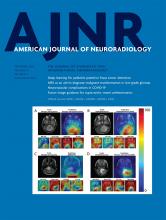Review ArticleAdult Brain
Open Access
Diagnostic Performance of PET and Perfusion-Weighted Imaging in Differentiating Tumor Recurrence or Progression from Radiation Necrosis in Posttreatment Gliomas: A Review of Literature
N. Soni, M. Ora, N. Mohindra, Y. Menda and G. Bathla
American Journal of Neuroradiology September 2020, 41 (9) 1550-1557; DOI: https://doi.org/10.3174/ajnr.A6685
N. Soni
aDepartment of Radiology (N.S., Y.M., G.B.), University of Iowa Hospitals and Clinics, Iowa City, Iowa
M. Ora
bDepartment of Radiodiagnosis (M.O., N.M.), Sanjay Gandhi Post Graduate Institute of Medical Sciences, Institute of Nuclear Medicine, Lucknow, India
N. Mohindra
bDepartment of Radiodiagnosis (M.O., N.M.), Sanjay Gandhi Post Graduate Institute of Medical Sciences, Institute of Nuclear Medicine, Lucknow, India
Y. Menda
aDepartment of Radiology (N.S., Y.M., G.B.), University of Iowa Hospitals and Clinics, Iowa City, Iowa
G. Bathla
aDepartment of Radiology (N.S., Y.M., G.B.), University of Iowa Hospitals and Clinics, Iowa City, Iowa

References
- 1.↵
- 2.↵
- 3.↵
- 4.↵
- 5.↵
- 6.↵
- 7.↵
- Bahrami N,
- Piccioni D,
- Karunamuni R, et al
- 8.↵
- 9.↵
- 10.↵
- 11.↵
- Essig M,
- Shiroishi MS,
- Nguyen TB, et al
- 12.↵
- Welker K,
- Boxerman J,
- Kalnin A, et al
- 13.↵
- 14.↵
- Barajas RF, Jr..,
- Chang JS,
- Segal MR, et al
- 15.↵
- Young RJ,
- Gupta A,
- Shah AD, et al
- 16.↵
- 17.↵
- Prager AJ,
- Martinez N,
- Beal K, et al
- 18.↵
- Wang S,
- Martinez-Lage M,
- Sakai Y, et al
- 19.↵
- 20.↵
- 21.↵
- Yun TJ,
- Park CK,
- Kim TM, et al
- 22.↵
- 23.↵
- Zakhari N,
- Taccone MS,
- Torres CH, et al
- 24.↵
- 25.↵
- Seeger A,
- Braun C,
- Skardelly M, et al
- 26.↵
- 27.↵
- 28.↵
- 29.↵
- van Dijken BRJ,
- van Laar PJ,
- Holtman GA, et al
- 30.↵
- 31.↵
- 32.↵
- 33.↵
- 34.↵
- 35.↵
- 36.↵
- 37.↵
- 38.↵
- Qiao Z,
- Zhao X,
- Wang K, et al
- 39.↵
- 40.↵
- 41.↵
- 42.↵
- Terakawa Y,
- Tsuyuguchi N,
- Iwai Y, et al
- 43.↵
- 44.↵
- 45.↵
- 46.↵
- Rachinger W,
- Goetz C,
- Pöpperl G, et al
- 47.↵
- Pöpperl G,
- Götz C,
- Rachinger W, et al
- 48.↵
- 49.↵
- Grosu A-L,
- Astner ST,
- Riedel E, et al
- 50.↵
- Jeong SY,
- Lee TH,
- Rhee CH, et al
- 51.↵
- 52.↵
- 53.↵
- Patronas N,
- Di Chiro G,
- Brooks R, et al
- 54.↵
- 55.↵
- Jena A,
- Taneja S,
- Jha A, et al
- 56.↵
- Nihashi T,
- Dahabreh IJ,
- Terasawa T
- 57.↵
- 58.↵
- 59.↵
- 60.↵
- Ullrich R,
- Backes H,
- Li H, et al
- 61.↵
- Peck M,
- Pollack HA,
- Friesen A, et al
- 62.↵
- Zeisel SH
- 63.↵
- 64.↵
- Pyka T,
- Gempt J,
- Ringel F, et al
- 65.↵
- 66.↵
- 67.↵
- Prat R,
- Galeano I,
- Lucas A, et al
- 68.↵
- Hatzoglou V,
- Yang TJ,
- Omuro A, et al
- 69.↵
- 70.↵
- 71.↵
- Sogani SK,
- Jena A,
- Taneja S, et al
- 72.↵
- 73.↵
- Verger A,
- Filss CP,
- Lohmann P, et al
- 74.↵
- 75.↵
- 76.↵
- 77.↵
- 78.↵
- 79.↵
- 80.↵
- 81.↵
In this issue
American Journal of Neuroradiology
Vol. 41, Issue 9
1 Sep 2020
Advertisement
N. Soni, M. Ora, N. Mohindra, Y. Menda, G. Bathla
Diagnostic Performance of PET and Perfusion-Weighted Imaging in Differentiating Tumor Recurrence or Progression from Radiation Necrosis in Posttreatment Gliomas: A Review of Literature
American Journal of Neuroradiology Sep 2020, 41 (9) 1550-1557; DOI: 10.3174/ajnr.A6685
0 Responses
Diagnostic Performance of PET and Perfusion-Weighted Imaging in Differentiating Tumor Recurrence or Progression from Radiation Necrosis in Posttreatment Gliomas: A Review of Literature
N. Soni, M. Ora, N. Mohindra, Y. Menda, G. Bathla
American Journal of Neuroradiology Sep 2020, 41 (9) 1550-1557; DOI: 10.3174/ajnr.A6685
Jump to section
Related Articles
Cited By...
This article has been cited by the following articles in journals that are participating in Crossref Cited-by Linking.
- Anna Y. Li, Michael IvFrontiers in Radiology 2022 2
- Shumyla Jabeen, Arpana Arbind, Dinesh Kumar, Pardeep Kumar Singh, Jitender Saini, Nishanth Sadashiva, Uday Krishna, Arivazhagan Arimappamagan, Vani Santosh, Chandana NagarajEuropean Journal of Hybrid Imaging 2021 5 1
- Emily J. Smith, Anant Naik, Annabelle Shaffer, Mahima Goel, David T. Krist, Edward Liang, Charuta G. Furey, William K. Miller, Michael T. Lawton, Daniel H. Barnett, Blake Weis, Ahmed Rizk, Ron S. Smith, Wael HassaneenJournal of Neuro-Oncology 2023 162 1
- Gilbert Youssef, Patrick Y. WenCurrent Neurology and Neuroscience Reports 2024 24 2
- N. Soni, M. Ora, A. Jena, P. Rana, R. Mangla, S. Ellika, J. Almast, S. Puri, S.P. MeyersAmerican Journal of Neuroradiology 2023 44 3
- Aliya Anil, Ashley M. Stokes, Renee Chao, Leland S. Hu, Lea Alhilali, John P. Karis, Laura C. Bell, C. Chad QuarlesFrontiers in Oncology 2023 13
- Sebastian Johannes Müller, Eya Khadhraoui, Oliver Ganslandt, Hans Henkes, Georg Alexander GihrJournal of Neuro-Oncology 2024 166 3
- Krishna Ranjith Kadali, Nathalie Nierobisch, Fabienne Maibach, Philip Heesen, Paula Alcaide-Leon, Martin Hüllner, Michael Weller, Zsolt Kulcsar, Nicolin HaincScientific Reports 2025 15 1
- A. Hilario, E. Salvador, A. Cardenas, J. Romero, C. Lechuga, Z. Chen, A. Martinez de Aragon, A. Perez-Nuñez, A. Hernandez-Lain, J. Sepulveda, A. Lagares, O. Toldos, V. Rodriguez-Gonzalez, A. RamosNeuroradiology 2024 66 3
- Burak Kocak, Ismail Mese, Ece Ates KusEuropean Radiology 2025 35 8
More in this TOC Section
Similar Articles
Advertisement











